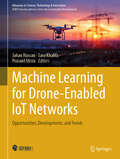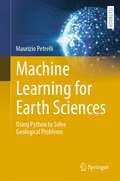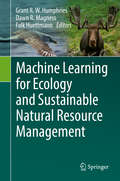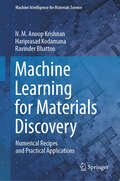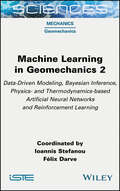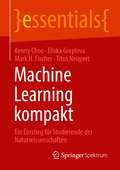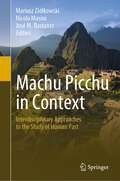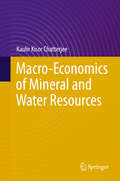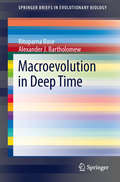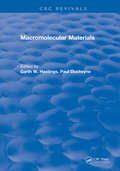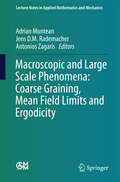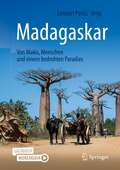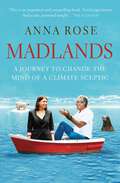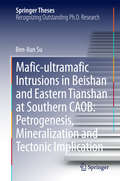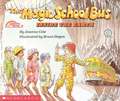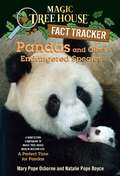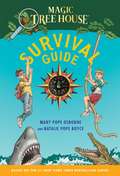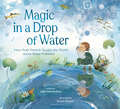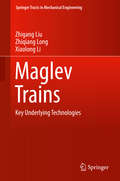- Table View
- List View
Machine Learning for Drone-Enabled IoT Networks: Opportunities, Developments, and Trends (Advances in Science, Technology & Innovation)
by Sara Khalifa Jahan Hassan Prasant MisraThis book aims to explore the latest developments, challenges, and opportunities in the application of machine learning techniques to enhance the performance and efficiency of IoT networks assisted by aerial unmanned vehicles (UAVs), commonly known as drones. The book aims to include cutting edge research and development on a number of areas within the topic including but not limited to: •Machine learning algorithms for drone-enabled IoT networks •Sensing and data collection with drones for IoT applications •Data analysis and processing for IoT networks assisted by drones •Energy-efficient and scalable solutions for drone-assisted IoT networks •Security and privacy issues in drone-enabled IoT networks •Emerging trends and future directions in ML for drone-assisted IoT networks.
Machine Learning for Earth Sciences: Using Python to Solve Geological Problems (Springer Textbooks in Earth Sciences, Geography and Environment)
by Maurizio PetrelliThis textbook introduces the reader to Machine Learning (ML) applications in Earth Sciences. In detail, it starts by describing the basics of machine learning and its potentials in Earth Sciences to solve geological problems. It describes the main Python tools devoted to ML, the typival workflow of ML applications in Earth Sciences, and proceeds with reporting how ML algorithms work. The book provides many examples of ML application to Earth Sciences problems in many fields, such as the clustering and dimensionality reduction in petro-volcanological studies, the clustering of multi-spectral data, well-log data facies classification, and machine learning regression in petrology. Also, the book introduces the basics of parallel computing and how to scale ML models in the cloud. The book is devoted to Earth Scientists, at any level, from students to academics and professionals.
Machine Learning for Ecology and Sustainable Natural Resource Management
by Falk Huettmann Grant R. W. Humphries Dawn R. Magness<p>Ecologists and natural resource managers are charged with making complex management decisions in the face of a rapidly changing environment resulting from climate change, energy development, urban sprawl, invasive species and globalization. Advances in Geographic Information System (GIS) technology, digitization, online data availability, historic legacy datasets, remote sensors and the ability to collect data on animal movements via satellite and GPS have given rise to large, highly complex datasets. These datasets could be utilized for making critical management decisions, but are often “messy” and difficult to interpret. Basic artificial intelligence algorithms (i.e., machine learning) are powerful tools that are shaping the world and must be taken advantage of in the life sciences. In ecology, machine learning algorithms are critical to helping resource managers synthesize information to better understand complex ecological systems. <p>Machine Learning has a wide variety of powerful applications, with three general uses that are of particular interest to ecologists: <p> <li>(1) data exploration to gain system knowledge and generate new hypotheses, <li>(2) predicting ecological patterns in space and time, <li>and (3) pattern recognition for ecological sampling.</li> <p> <p> Machine learning can be used to make predictive assessments even when relationships between variables are poorly understood. When traditional techniques fail to capture the relationship between variables, effective use of machine learning can unearth and capture previously unattainable insights into an ecosystem's complexity. Currently, many ecologists do not utilize machine learning as a part of the scientific process. This volume highlights how machine learning techniques can complement the traditional methodologies currently applied in this field.</p>
Machine Learning for Materials Discovery: Numerical Recipes and Practical Applications (Machine Intelligence for Materials Science)
by Hariprasad Kodamana Ravinder Bhattoo N. M. KrishnanFocusing on the fundamentals of machine learning, this book covers broad areas of data-driven modeling, ranging from simple regression to advanced machine learning and optimization methods for applications in materials modeling and discovery. The book explains complex mathematical concepts in a lucid manner to ensure that readers from different materials domains are able to use these techniques successfully. A unique feature of this book is its hands-on aspect—each method presented herein is accompanied by a code that implements the method in open-source platforms such as Python. This book is thus aimed at graduate students, researchers, and engineers to enable the use of data-driven methods for understanding and accelerating the discovery of novel materials.
Machine Learning in Geomechanics 1: Overview of Machine Learning, Unervised Learning, Regression, Classification and Artificial Neural Networks (ISTE Consignment)
by Ioannis Stefanou F Lix DarveMachine learning has led to incredible achievements in many different fields of science and technology. These varied methods of machine learning all offer powerful new tools to scientists and engineers and open new paths in geomechanics. The two volumes of Machine Learning in Geomechanics aim to demystify machine learning. They present the main methods and provide examples of its applications in mechanics and geomechanics. Most of the chapters provide a pedagogical introduction to the most important methods of machine learning and uncover the fundamental notions underlying them. Building from the simplest to the most sophisticated methods of machine learning, the books give several hands-on examples of coding to assist readers in understanding both the methods and their potential and identifying possible pitfalls.
Machine Learning in Geomechanics 2: Data-Driven Modeling, Bayesian Inference, Physics- and Thermodynamics-based Artificial Neural Networks and Reinforcement Learning (ISTE Consignment)
by Ioannis Stefanou Félix DarveMachine learning has led to incredible achievements in many different fields of science and technology. These varied methods of machine learning all offer powerful new tools to scientists and engineers and open new paths in geomechanics. The two volumes of Machine Learning in Geomechanics aim to demystify machine learning. They present the main methods and provide examples of its applications in mechanics and geomechanics. Most of the chapters provide a pedagogical introduction to the most important methods of machine learning and uncover the fundamental notions underlying them. Building from the simplest to the most sophisticated methods of machine learning, the books give several hands-on examples of coding to assist readers in understanding both the methods and their potential and identifying possible pitfalls.
Machine Learning kompakt: Ein Einstieg für Studierende der Naturwissenschaften (essentials)
by Kenny Choo Eliska Greplova Mark H. Fischer Titus NeupertDieses essential befasst sich mit Anwendungen des maschinellen Lernens in verschiedenen Bereichen der Naturwissenschaften. Es behandelt geläufige Strukturen und Algorithmen, um Daten mit den Techniken des maschinellen Lernens zu analysieren. Zunächst werden Methoden eingeführt, die an klassischen statistischen Analysen andocken und auf soliderem mathematischem Fundament stehen. Die Autoren machen mit den verschiedenen Strukturen für künstliche neuronale Netzwerke vertraut und zeigen die jeweiligen Anwendungsgebiete.
Machu Picchu in Context: Interdisciplinary Approaches to the Study of Human Past
by Nicola Masini Mariusz Ziółkowski José M. BastanteThis book aims at integrating archaeology with science in order to provide additional information with respect to a traditional archaeological anthropological perspective. It sheds light on Incan culture, the relation between human frequentation and environmental changes, the Incan architecture in relation with Andean cosmovision using, for the first time, diverse technological and scientific approaches including LiDAR remote sensing, geophysics and radio carbon dating. A number of recent studies conducted by Polish, Italian and Peruvian scientific missions in Machu Picchu, Chachabamba and Cusco are presented and discussed.Chapter 5 is available open access under a Creative Commons Attribution-ShareAlike 4.0 International License via link.springer.com.
Macro-Economics of Mineral and Water Resources
by Kaulir Kisor ChatterjeeThis book highlights the indispensability of minerals, the vulnerability of humans and issues faced by governments around the world regarding the management of natural resources. It addresses the growing land-ecology-mining conflicts, energy security and water policies of different countries bringing these issues into focus and critically analyzing them. The book discusses the role of governments regarding the security-centric issues pertaining to sustainability of mineral supply and the welfare-centric aspects of sustainable development of mineral resources. The latter includes the current trends for corporate social responsibility, political viability of mining projects, industrial ethics, human health and human resource development. The Annexure I is unique: It is a list of 925 familiar consumer products and processes with the names of the minerals, metals and rocks as well as the intermediate chemicals and alloys that go into the making of that product or process alongside each. Annexure II is an up-to-date, exhaustive list of about 835 minerals, metals, rocks and intermediate chemicals and alloys and against each of them is a list of the names of the end products and processes for which they are used. These two annexures will serve as a day-to-day reference source for teachers, students and professionals concerned with minerals as well as other interested readers. The book will be useful to any university/institution with undergraduate and post-graduate teaching/research facilities and libraries in the field of geology, mining, mineral economics, planning and natural-resource management. About the Author Kaulir Kisor Chatterjee studied Applied Geology at the Indian School of Mines, Dhanbad for his post-graduate and PhD degrees. He served in the Indian Bureau of Mines for over three decades and retired in early 2004, as Chief Mineral Economist. Post-retirement, he has occupied himself mostly with writing, teaching and lecturing in various institutions of repute in India on the subject of mineral economics. Besides 50 technical papers, he has authored eight books. He has worked in various Government committees and expert groups and was involved in organization of national mineral inventory; UN Framework Classification system of mineral resources; rationalisation of the mineral taxation, royalty and mineral legislation framework in India. He has been examiner and member of selection boards of UPSC, India and is also a recognised guide of the Nagpur University for doctoral research. His resume has been included in the Marquis Who Is Who of the World and in the 2000 Outstanding Intellectuals of the 21st Century, Cambridge.
Macroeconomic Fluctuations in the Caribbean: the Role of Climatic and External Shocks
by Paul Cashin Sebastián SosaA report from the International Monetary Fund.
Macroevolution in Deep Time
by Alexander J. Bartholomew Rituparna BoseThe prerequisite to investigating the underlying causes behind mass extinction is a profound understanding of the evolutionary history of both living and dead species. It is especially important to appreciate the significance of such studies in extinct organisms; especially in organisms that were abundant in a certain geologic era, but have subsequently dwindled or become extinct. Such studies should help to accurately evaluate patterns of evolution in extinct species lineages and help predict the same in its modern analogs. The book includes cutting edge research in evolutionary biology that should serve as a starting point for conservation.
Macromolecular Characterization of Hydrocarbons for Sustainable Future: Applications to Hydrocarbon Value Chain (Green Energy and Technology)
by Uttam Kumar BhuiThis book discusses the macromolecular characterization of hydrocarbon components and their industrial applications for sustainable future development. It provides efficient integrated solutions and feasible industrial applications for sustainable cleaner and greener future. The book covers recent trends in the use of hydrocarbons such as crude oil, coal and shale, biomass and other carbon materials. Various topics covered in this book include challenges in mature field redevelopment, enhanced oil recovery, optical characteristics of petroleum crudes-surfactants-brine solutions, challenges and issues in processing hydrocarbons, 'coal for future cleaner fuel and chemicals' and 'biomass for fuels and chemicals'. The book is useful for the researchers and professionals working in the area of petroleum engineering.
Macromolecular Materials
by HastingsThis volume deals with some basic considerations of structure and its relation to function. After outlining some basic principles in the first chapter, including manufacturing effects, structural determination is discussed in detail. This is important since adequate characterization in terms of molecular size is necessary for a proper understanding and suse. The theme of interrelationships between structure and properties is developed in the next chapters. The second part of the volume deals with selected applications in which the development and sue of macromolecultar materials in specific applications is described.The selection of applications includes synthetic and natural polymers and the range of medical areas involved include orthopedics, dialysis, drug release (macromolecular pharmacology) blood contact, and plastic surgery. Since the list could not be completely comprehensive, these represent areas of special development or of continuing problems.
Macroscopic Limits of Quantum Systems: Munich, Germany, March 30 - April 1 2017 (Springer Proceedings in Mathematics & Statistics #270)
by Daniela Cadamuro Maximilian Duell Wojciech Dybalski Sergio SimonellaBased on the workshop of the same name, this proceedings volume presents selected research investigating the mathematics of collective phenomena emerging from quantum theory at observable scales. Featured contributions from leading scientists provide a thorough overview of current and active research. Methods from functional analysis, spectral theory, renormalization group theory, and variational calculus are used to prove rigorous results in quantum physics. Topics include superconductivity and mathematical aspects of the BCS theory, the Jellium model and Bose-Einstein condensation, among others. Presenting technical details in an accessible way, this book serves as an introduction to research for advanced graduate students and is suitable for specialists in mathematical physics.The workshop “Macroscopic Limits of Quantum Systems” was held over three days in the spring of 2017 at the Technical University of Munich. The conference celebrated the achievements of Herbert Spohn and his reception of the Max Planck Medal.
Macroscopic and Large Scale Phenomena: Coarse Graining, Mean Field Limits and Ergodicity
by Adrian Muntean Jens Rademacher Antonios ZagarisThis book is the offspring of a summer school school "Macroscopic andlarge scale phenomena: coarse graining, mean field limits and ergodicity", which washeld in 2012 at the University of Twente, the Netherlands. The focus lies onmathematically rigorous methods for multiscale problems of physical origins. Each of the four book chapters is based on a set of lectures deliveredat the school, yet all authors have expanded and refined their contributions. Francois Golsedelivers a chapter on the dynamics of large particle systems in the mean fieldlimit and surveys the most significant tools and methods to establish suchlimits with mathematical rigor. Golse discusses in depth a variety of examples,including Vlasov--Poisson and Vlasov--Maxwell systems. Lucia Scardia focuseson the rigorous derivation of macroscopic models using $\Gamma$-convergence, amore recent variational method, which has proved very powerful for problems inmaterial science. Scardia illustrates this by various basic examples and a moreadvanced case study from dislocation theory. Alexander Mielke'scontribution focuses on the multiscale modeling and rigorous analysis ofgeneralized gradient systems through the new concept of evolutionary$\Gamma$-convergence. Numerous evocative examples are given, e. g. , relating toperiodic homogenization and the passage from viscous to dry friction. Martin Göll and EvgenyVerbitskiy conclude this volume, taking a dynamical systems and ergodic theoryviewpoint. They review recent developments in the study of homoclinic pointsfor certain discrete dynamical systems, relating to particle systems viaergodic properties of lattices configurations.
Madagaskar - Von Makis, Menschen und einem bedrohten Paradies
by Lennart PyritzEin Buch, das Madagaskar in seinen vielfältigen Facetten zeigt, untermalt mit ausgezeichneten Fotos. Angesprochen werden alle reise- und naturbegeisterten Leser. Ein tagebuchartiger, amüsant geschriebener Erfahrungsbericht über eine 14-monatige biologische Feldarbeit in Madagaskar in Form kurzer Texte (siehe: www.spektrumdirekt.de/madagaskar) ist ergänzt durch zahlreiche hochqualitative Fotos. Hauptsächlich biologische Themen werden erörtert, aber auch Erfahrungen mit madagassischer Kultur, Land und Leuten. Einzelne Abschnitte werden durch allgemeinverständlich geschriebene Infoboxen von Experten zum jeweiligen Thema ergänzt. Den zweiten Teil des Buches bildet eine Sammlung von Essays mit Fotos, ein madagassisches Zitat am Anfang führt hin zu madagassischer Fauna, Flora, Naturschutz, Geschichte, Politik, Kultur und Lebensweise. Verfasst sind die Beiträge von Autoren wie Prof. Peter Kappeler vom Deutschen Primatenzentrum, Dr. Roland Hilgartner, Leiter des Affenbergs Salem, und seiner madagassischen Frau Mamisolo sowie Dr. Christoph Schwitzer vom Zoo Bristol und Madagaskar-Koordinator der IUCN SSC Primate Specialist Group.
Madlands: A Journey to Change the Mind of a Climate Sceptic
by Anna RoseAn idealistic twenty-something environmentalist. A retired right-wing finance minister.All their lives, they've happily ignored each other.Until now.Anna Rose, environmental crusader since the age of fourteen and co-founder of the Australian Youth Climate Coalition, is on a mission. This is the story of her biggest challenge yet: a whirlwind journey around the world with conservative powerbroker and arch climate sceptic Nick Minchin. From a remote Hawaiian volcano to a cosmic ray laboratory in Geneva, Anna rolls out the biggest names in science to try and change Nick's mind.It's a journey to tell the story of what's happening to our climate—not just to one man, but to a nation divided on the biggest issue of our times. Nick and Anna challenge each other's views, provoking each other to confront closely held assumptions and question our responsibilities as citizens living in uncertain times.
Mafic-ultramafic Intrusions in Beishan and Eastern Tianshan at Southern CAOB: Petrogenesis, Mineralization and Tectonic Implication
by Ben-Xun SuThe widespread mafic-ultramafic complexes in the Earth are well-known as their hosting Ni-Cu-PGE ore deposits, and their petrogenesis and mineralization have become hot issues in the geological studies. This thesis comprehensively investigated the petrology, mineralogy, geochemistry and geochronology of several mafic-ultramafic complexes in the Beishan Terrane, southern Central Asian Orogenic Belt aimed at systematically determining the mineralization and petrogenetic processes responsible for the formation of the complexes and placing constraints on the tectonic evolution of the Eastern Tianshan and Beishan, and the Early Permian mantle plume. The thesis identified mineralizing indicators of Ni-Cu sulfide deposits and defined the roles of partial melting, fractional crystallization, crustal assimilation and magma injection. The systematical isotopic compositions revealed the mantle source of the mafic-ultramafic complexes had undergone the subduction-related modifications both from the South Tianshan Ocean and subsequently the Junggar Ocean, and that the complexes were emplaced in the period of 269-285 Ma coeval with the 280 Ma mantle plume event in the Tarim Craton. The results of this thesis provide new insights about the tectonic setting, magma evolution, ore genesis, and exploration implications of the mafic-ultramafic complexes in Central Asian Orogenic Belt. Dr. Benxun Su works at the Institute of Geology and Geophysics, Chinese Academy of Sciences, China.
Magic School Bus: Inside the Earth
by Joanna ColeTo celebrate its 20th anniversary, Scholastic is re-releasing the ten original Magic School Bus titles in paperback. With updated scientific information, the bestselling science series ever is back! Rock collecting has never been quite like this! When the class forgets to do its homework, a fieldtrip through the Earth's crust, into the center of the Earth, and out through a volcano will teach them not to forget their assignments again - and then some!
Magic School Bus: Ocean Adventure (Scholastic Reader, Level 2)
by Mary Kay CarsonNow early readers can take a ride on the Magic School Bus!With the help of Ms. Frizzle, young readers can develop their reading skills while they pick up fun facts about the world's ocean. Ms. Frizzle's class will teach you everything you ever wanted to know about the deep sea through this engaging and accesible reader. This is a great introduction to the Magic School Bus program.
Magic Tree House Fact Tracker #12: Sabertooths and the Ice Age
by Mary Pope Osborne Sal Murdocca Natalie Pope BoyceMagic Tree House Research Guides are now Magic Tree House Fact Trackers! Track the facts with Jack and Annie! When Jack and Annie got back from their adventure in Magic Tree House #7: Sunset of the Sabertooth, they had lots of questions. What was it like to live in the Ice Age? How did early humans stay warm enough to survive? Who made the first cave paintings? What happened to saber-toothed cats and woolly mammoths? Find out the answers to these questions and more as Jack and Annie track the facts. Filled with up-to-date information, photos, illustrations, and fun tidbits from Jack and Annie, the Magic Tree House Fact Trackers are the perfect way for kids to find out more about the topics they discovered in their favorite Magic Tree House adventures.
Magic Tree House Fact Tracker #26: Pandas and Other Endangered Species (Magic Tree House (R) Fact Tracker #26)
by Mary Pope Osborne Sal Murdocca Natalie Pope BoyceWhen Jack and Annie got back from their adventure in Magic Tree House #48: A Perfect Time for Pandas they had lots of questions. What do pandas eat? Where do they live? Why are snow leopards so scarce? How can we help? Find out the answers to these questions and more as Jack and Annie track the facts. Filled with up-to-date information, photos, illustrations, and fun tidbits from Jack and Annie, the Magic Tree House Fact Trackers are the perfect way for kids to find out more about the topics they discovered in their favorite Magic Tree House adventures.From the Trade Paperback edition.
Magic Tree House Survival Guide (Magic Tree House (R))
by Mary Pope Osborne Sal Murdocca Natalie Pope BoyceLions and tigers and bears--oh, man!Jack and Annie have survived all kinds of dangers on their adventures in the magic tree house. Find out how you can survive lots of scary situations, including sharks, earthquakes, fires, shipwrecks, and many more! With full-color photographs and illustrations, facts about real-life survival stories, and tips from Jack and Annie, this is a must-have for all survivors of the bestselling Magic Tree House series.Have more fun with Jack and Annie on the Magic Tree House® website at MagicTreeHouse.com.
Magic in a Drop of Water: How Ruth Patrick Taught the World about Water Pollution
by Julie WinterbottomAn entertaining and gorgeous picture book biography of scientist and environmental hero Ruth Patrick, one of the first to warn about the dangers of pollution.A brilliant scientist and intrepid explorer, the ecologist Ruth Patrick taught the world how to care for the environment. She studied water pollution long before it became a public concern and gave other scientists the tools to do something about it. Born in 1907, Ruth Patrick was one of the only women in her field when she made her breakthrough discovery about biodiversity and the ecosystem of rivers, forever changing how ecologists understand pollution.Lyrically, joyfully written, exquisitely illustrated, and full of fascinating details and a rich afterword and timeline, this STEM biography will inspire readers who love the environment to follow their passion and curiosity.
Maglev Trains
by Xiaolong Li Zhigang Liu Zhiqiang LongThe motion of the train depends on the traction of linear motors in the vehicle. This book describes a number of essential technologies that can ensure the safe operation of Maglev trains, such as suspension and orientation technologies, network control and diagnosis technologies. This book is intended for researchers, scientists, engineers and graduate students involved in the rail transit industry, train control and diagnosis, and Maglev technology.
